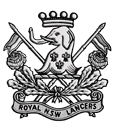1st Royal New South Wales Lancers
| 1st Royal New South Wales Lancers | |
|---|---|
Parramatta, New South Wales | |
| Engagements | Second Boer War First World War Second World War |
| Insignia | |
Cap badge 1st Royal New South Wales Lancers |  |
The 1st Royal New South Wales Lancers was an
The Lancers was reformed after the Second World War in 1948 as a reserve formation in the
History
Second Boer War
The unit's complicated lineage included the New South Wales Lancers, which had been first formed as the New South Wales Cavalry, a reserve colonial unit in 1885 and had later served in the Second Boer War.[1][2] A half squadron of the Regiment had been in Great Britain where they participated in the Diamond Jubilee of Queen Victoria. When war was declared they were transported to South Africa. The Lancers contributed a squadron that had served under John French in Lord Roberts' army, and participated in a counter-invasion of the Orange Free State that eventually lifted the Siege of Kimberley in 1900.[3][4]
First World War and inter-war years
In August 1914, following the outbreak of the First World War, the

Upon establishment, the men from the 7th ALH formed the bulk of Regimental Headquarters, and A and B Squadrons, while AIF volunteers made up the remainder of the new unit. Among them were veterans of the New South Wales Lancers who had fought in South Africa.
The regiment returned to Australia in mid-1919,
Second World War

At the start of the Second World War, due to the limitations of the Defence Act (1903), which prevented the government from sending the Militia to fight outside Australian territory, it was decided to raise an all volunteer force to serve overseas. This force was known as the
In March 1942, the regiment was again renamed, being converted to the 1st Motor Regiment.
On 1 June 1944, the unit was renamed the 1st Armoured Regiment.
Post-war era
Following the end of the war the Australian Army was
Battle honours
The regiment has received the following battle honours:[16]
- Boer War: South Africa 1899–1902;[1]
- First World War:
- Second World War: Milford Highway.[6]
Notes
- Footnotes
- Citations
- ^ a b c d e f g h "1st RNSWL". New South Wales Lancers Memorial Museum. 2010. Archived from the original on 6 June 2010. Retrieved 15 June 2010.
- ^ a b c d e "1st Light Horse Regiment". First World War, 1914–1918 units. Australian War Memorial. Archived from the original on 13 March 2011. Retrieved 8 September 2010.
- ^ Paterson 1934, pp. 188–9, 111–3.
- ^ "New South Wales Lancers". South Africa, 1899–1902 (Boer War) units. Australian War Memorial. Archived from the original on 31 October 2013. Retrieved 26 January 2013.
- ^ Grey 2008, p. 125.
- ^ a b c d e f g h i j "1st Armoured Regiment". Second World War, 1939–1945 units. Australian War Memorial. Archived from the original on 17 September 2009. Retrieved 31 October 2009.
- ^ Grey 2008, p. 146.
- ^ a b c d Hopkins 1978, p. 319.
- ^ Hopkins 1978, p. 128.
- ^ Hopkins 1978, p. 137–138.
- ^ Coulthard-Clark 1998, p. 254.
- ^ Hopkins 1978, pp. 166–173.
- ^ Grey 2008, pp. 200–201.
- ^ Hopkins 1978, p. 323.
- ^ Hopkins 1978, p. 183.
- ^ Festberg 1972, p. 39.
References
- Coulthard-Clark, Chris (1998). Where Australians Fought: The Encyclopaedia of Australia's Battles. St Leonards, New South Wales: Allen & Unwin. ISBN 1-86448-611-2.
- Festberg, Alfred (1972). The Lineage of the Australian Army. Melbourne, Victoria: Allara Publishing. ISBN 978-0-85887-024-6.
- ISBN 978-0-521-69791-0.
- ISBN 0-642-99407-2.
- OCLC 33952128.
